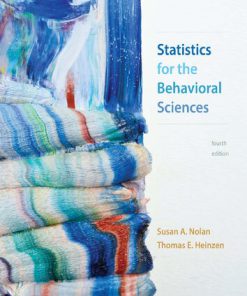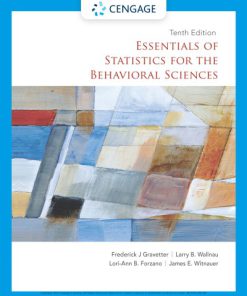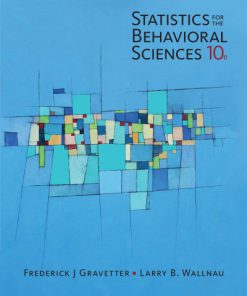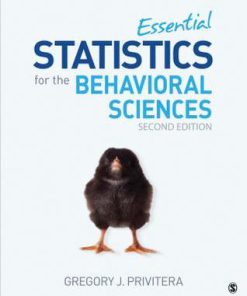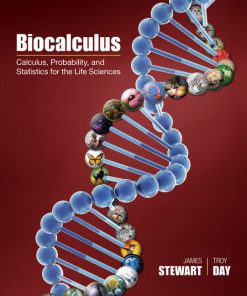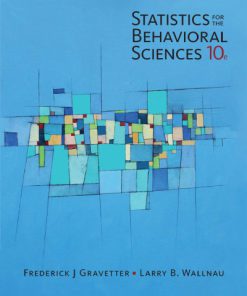Statistics for the Life Sciences 1st edition by Myra Samuels 9780321989581 0321989589
$50.00 Original price was: $50.00.$25.00Current price is: $25.00.
Statistics for the Life Sciences 1st edition by Myra Samuels – Ebook PDF Instant Download/Delivery:9780321989581,0321989589
Full download Statistics for the Life Sciences 1st edition after payment
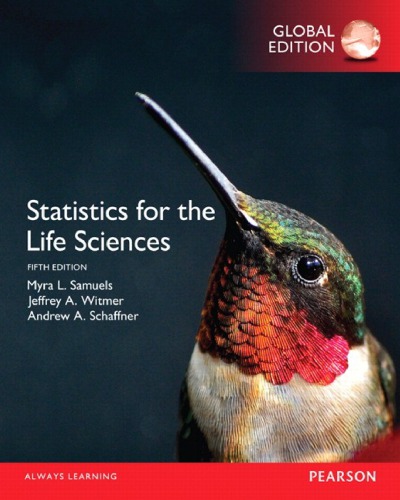
Product details:
ISBN 10:0321989589
ISBN 13:9780321989581
Author:Myra Samuels
Statistics for the Life Sciences Statistics for the Life Sciences, Fourth Edition, covers the key concepts of statistics as applied to the life sciences, while incorporating the tools and themes of modern data analysis. This text uses an abundance of real data in the exercises and examples, and minimizes computation, so that readers can focus on the statistical concepts and issues, not the mathematics. Basic algebra is assumed as… Full description
Statistics for the Life Sciences 1st Table of contents:
Chapter 1 Introduction
Objectives
1.1 Statistics and the Life Sciences
Example 1.1.1 Vaccine for Anthrax
Example 1.1.2 Bacteria and Cancer
Example 1.1.3 Flooding and ATP
Example 1.1.4 MAO and Schizophrenia
Example 1.1.5 Food Choice by Insect Larvae
Example 1.1.6 Body Size and Energy Expenditure
A Look Ahead
1.2 Types of Evidence
Example 1.2.1 Lightning and Deafness
Example 1.2.2 Sexual Orientation
Example 1.2.3 Health and Marriage
Example 1.2.4 Toxicity in Dogs
Example 1.2.5 Autism
Example 1.2.6 Bronchial Asthma
Example 1.2.7 Renal Denervation
Blinding
The Need for Control Groups
Example 1.2.8 Clofibrate
Example 1.2.9 The Common Cold
Example 1.2.10 Diet and Cancer Prevention
Historical Controls
Example 1.2.11 Coronary Artery Disease
Example 1.2.12 Healthcare Trials
Exercises 1.2.1–1.2.10
1.3 Random Sampling
Samples and Populations
Remark
Definition of a Simple Random Sample
Employing Randomness
How to Choose a Random Sample
Example 1.3.1
Remark
Remark
Practical Concerns When Random Sampling
Nonsimple Random Sampling Methods
Example 1.3.2 La Graciosa Thistle
Example 1.3.3 Sand Crabs
Sampling Error
Example 1.3.4 Lengths of Fish
Example 1.3.5 Sizes of Nerve Cells
Example 1.3.6 Sucrose in Beet Roots
Example 1.3.7 Fungus Resistance in Corn
Example 1.3.8 Nitrite Metabolism
Example 1.3.9 Treatment of Ulcerative Colitis
Nonsampling Errors
Example 1.3.10 Abortion Funding
Example 1.3.11 HIV Testing
Example 1.3.12 Sugar and Hyperactivity
Exercises 1.3.1–1.3.7
Chapter 2 Description of Samples and Populations
Objectives
2.1 Introduction
Variables
Observational Units
Notation for Variables and Observations
Exercises 2.1.1–2.1.5
2.2 Frequency Distributions
Example 2.2.1 Color of Poinsettias
Example 2.2.2 School Bags and Neck Pain
Example 2.2.3 Infant Mortality
Example 2.2.4 Litter Size of Sows
Relative Frequency
Example 2.2.5 Color of Poinsettias
Grouped Frequency Distributions
Example 2.2.6 Serum CK
Example 2.2.7 Heights of Students
Interpreting Areas in a Histogram
Shapes of Distributions
Example 2.2.8 Microfossils
Example 2.2.9 Cell Firing Times
Example 2.2.10 Brain Weight
Sources of Variation
Example 2.2.11 Weights of Seeds
Example 2.2.12 Serum ALT
Exercises 2.2.1–2.2.9
2.3 Descriptive Statistics: Measures of Center
The Median
Example 2.3.1 Weight Gain of Lambs
Example 2.3.2 Weight Gain of Lambs
The Mean
Example 2.3.3 Weight Gain of Lambs
Example 2.3.4 Weight Gain of Lambs
Robustness
Example 2.3.5 Weight Gain of Lambs
Visualizing the Mean and Median
Example 2.3.6 Cricket Singing Times
Mean versus Median
Exercises 2.3.1–2.3.14
2.4 Boxplots
Quartiles and the Interquartile Range
Example 2.4.1 Blood Pressure
Example 2.4.2 Pulse
Outliers
Example 2.4.3 Pulse
Example 2.4.4 Radish Growth in Light
Boxplots for data with no outliers
Example 2.4.5 Radish Growth
Boxplots for data with Outliers
Exercises 2.4.1–2.4.8
2.5 Relationships between Variables
Categorical–Categorical Relationships
Example 2.5.1 E. Coli Watershed Contamination
Example 2.5.2 E. Coli Watershed Contamination
Numeric–Categorical Relationships
Example 2.5.3 Radish Growth
Numeric–Numeric Relationships
Example 2.5.4 Whale Selenium
Exercises 2.5.1–2.5.4
2.6 Measures of Dispersion
The Range
Example 2.6.1 Blood Pressure
The Standard Deviation
Example 2.6.2 Chrysanthemum Growth
Example 2.6.3 Chrysanthemum Growth
An abbreviation
Interpretation of the Definition of s
Example 2.6.4 Chrysanthemum Growth
Why n − 1?
Example 2.6.5 Chrysanthemum Growth
Visualizing Measures of Dispersion
Example 2.6.6 Daily Gain of Cattle
Visualizing the Standard Deviation
Example 2.6.7 Daily Gain of Cattle
Estimating the SD from a Histogram
Example 2.6.8 Pulse after Exercise
Comparison of Measures of Dispersion
Exercises 2.6.1–2.6.17
2.7 Effect of Transformation of Variables (Optional)
Example 2.7.1 Weight
Example 2.7.2 Body Temperature
How Linear Transformations Affect the Frequency Distribution
Example 2.7.3 Body Temperature
How Linear Transformations Affect y¯ and s
Example 2.7.4 Additive Transformation
Other Statistics
Nonlinear Transformations
Example 2.7.5 Cricket Singing Times
Exercises 2.7.1–2.7.6
2.8 Statistical Inference
Example 2.8.1 Blood Types
Specifying the Population
Example 2.8.2 Blood Types
Example 2.8.3 Alcohol and MOPEG
Describing a Population
Proportions
Example 2.8.4 Oat Plants
Remark
Example 2.8.5 Lung Cancer
Other Descriptive Measures
Example 2.8.6 Tobacco Leaves
2.9 Perspective
Parameters and Statistics
A Look Ahead
Supplementary Exercises 2.S.1–2.S.24
Chapter 3 Probability and the Binomial Distribution
Objectives
3.1 Probability and the Life Sciences
3.2 Introduction to Probability
Basic Concepts
Example 3.2.1 Coin Tossing
Example 3.2.2 Coin Tossing
Example 3.2.3 Sampling Fruitflies
Frequency Interpretation of Probability
Example 3.2.4 Coin Tossing
Example 3.2.5 Coin Tossing
Example 3.2.6 Sampling Fruitflies
Probability Trees
Example 3.2.7 Coin Tossing
Combination of Probabilities
Example 3.2.8 Sampling Fruitflies
Example 3.2.9 Nitric Oxide
Hypothetical 1,000
Example 3.2.10 Nitric Oxide
Example 3.2.11 Medical Testing
Example 3.2.12 False Positives
Exercises 3.2.1–3.2.8
3.3 Probability Rules (Optional)
Basic Rules
Example 3.3.1 Blood Type
Addition Rules
Example 3.3.2 Hair Color and Eye Color
Example 3.3.3 Hair Color and Eye Color
Example 3.3.4 Hair Color and Eye Color
Multiplication Rules
Example 3.3.5 Coin Tossing
Example 3.3.6 Blood Type
Example 3.3.7 Hair Color and Eye Color
Example 3.3.8 Hand Size
Exercises 3.3.1–3.3.5
3.4 Density Curves
Relative Frequency Histograms and Density Curves
Example 3.4.1 Blood Glucose
Example 3.4.2 Blood Glucose
The Continuum Paradox
Probabilities and Density Curves
Example 3.4.3 Blood Glucose
Example 3.4.4 Tree Diameters
Exercises 3.4.1–3.4.5
3.5 Random Variables
Example 3.5.1 Dice
Example 3.5.2 Family Size
Example 3.5.3 Medications
Example 3.5.4 Heights of Men
Mean and Variance of a Random Variable
Example 3.5.5 Fish Vertebrae
Example 3.5.6 Dice
Example 3.5.7 Fish Vertebrae
Example 3.5.8 Dice
Adding and Subtracting Random Variables (Optional)
Example 3.5.9 Temperature
Example 3.5.10 Feet to Inches
Example 3.5.11 Mass
Exercises 3.5.1–3.5.10
3.6 The Binomial Distribution
The Independent-Trials Model
Example 3.6.1 Albinism
Example 3.6.2 Mutant Cats
An Example of the Binomial Distribution
Example 3.6.3 Albinism
The Binomial Distribution Formula
Notes on Table 2
Example 3.6.4 Mutant Cats
Remark
Computational Note
Example 3.6.5 Sampling Fruitflies
Example 3.6.6 Blood Type
Example 3.6.7 Blood Type
Mean and Standard Deviation of a Binomial
Example 3.6.8 Blood Type
Applicability of the Binomial Distribution
Application to Sampling
Contagion
Example 3.6.9 Chickenpox
Exercises 3.6.1–3.6.12
3.7 Fitting a Binomial Distribution to Data (Optional)
Example 3.7.1 Sexes of Children
Exercises 3.7.1–3.7.3
Supplementary Exercises 3.S.1–3.S.12
Chapter 4 The Normal Distribution
Objectives
4.1 Introduction
Example 4.1.1 Serum Cholesterol
Further Examples
Example 4.1.2 Blue Jay Bill Length
Example 4.1.3 Interspike Times in Nerve Cells
Example 4.1.4 Measurement Error
4.2 The Normal Curves
4.3 Areas under a Normal Curve
The Standardized Scale
Determining Areas for a Normal Curve
Example 4.3.1 Lengths of Fish
Inverse Reading of Table 3
Example 4.3.2 Lengths of Fish
Problem-Solving Tip
Exercises 4.3.1–4.3.17
4.4 Assessing Normality
Example 4.4.1 Serum Cholesterol
Example 4.4.2 Moisture Content
Normal Quantile Plots
How Normal Quantile Plots Work
Example 4.4.3 Height of Eleven Women
Example 4.4.4 Heights of Eleven Women
Making Decisions about Normality
Transformations for Nonnormal Data
Example 4.4.5 Lentil Growth
An Objective Measure of Abnormality: The Shapiro–Wilk Test (optional)
Example 4.4.6 Lentil Growth
Caution
Exercises 4.4.1–4.4.8
4.5 Perspective
Supplementary Exercises 4.S.1–4.S.21
Chapter 5 Sampling Distributions
Objectives
5.1 Basic Ideas
Sampling Variability
The Meta-Study
Example 5.1.1 Rat Blood Pressure
Example 5.1.2 Bacterial Growth
Example 5.1.3 Knee Replacement
Relationship to Statistical Inference
Exercises 5.1.1–5.1.5
5.2 The Sample Mean
The Sampling Distribution of Y¯
Example 5.2.1 Serum Cholesterol
Example 5.2.2 Weights of Seeds
Remark
Dependence on Sample Size
Example 5.2.3 Weights of Seeds
Populations, Samples, and Sampling Distributions
Example 5.2.4 Weights of Seeds
Other Aspects of Sampling Variability
Example 5.2.5 Weights of Seeds
Exercises 5.2.1–5.2.19
5.3 Illustration of the Central Limit Theorem (Optional)
Example 5.3.1 Eye Facets
Example 5.3.2 Reaction Time
Example 5.3.3 Reaction Time
Exercises 5.3.1–5.3.3
5.4 The Normal Approximation to the Binomial Distribution (Optional)
Remarks
Example 5.4.1 Normal Approximation to Binomial
The Continuity Correction
Example 5.4.2
Example 5.4.3
Remark
Example 5.4.4
How Large Must n Be?
Exercises 5.4.1–5.4.14
5.5 Perspective
Supplementary Exercises 5.S.1–5.S.13
Unit I Highlights and Study (Reflections on Chapters 1–5)
Reflections on Chapter 1
Reflections on Chapters 2–4
Reflections on Chapter 5
Unit I Summary Exercises
Unit II Inference for Means
Chapter 6 Confidence Intervals
Objectives
6.1 Statistical Estimation
Example 6.1.1 Butterfly Wings
6.2 Standard Error of the Mean
Example 6.2.1 Butterfly Wings
Standard Error versus Standard Deviation
Example 6.2.2 Lamb Birthweights
Example 6.2.3 Lamb Birthweights
Graphical Presentation of the SE and the SD
Example 6.2.4 MAO and Schizophrenia
Exercises 6.2.1–6.2.9
6.3 Confidence Interval for μ
Confidence Interval for μ: Basic Idea
Confidence Interval for μ: Mathematics
Student’s t Distribution
Confidence Interval for μ: Method
Example 6.3.1 Butterfly Wings
Example 6.3.2 Butterfly Wings
Remark
Confidence Intervals and Randomness
Example 6.3.3 Blue Jay Bill Length
Interpretation of a Confidence Interval
Example 6.3.4 Bone Mineral Density
Example 6.3.5 Seeds per Fruit
Relationship to Sampling Distribution of y¯
One-Sided Confidence Intervals
Example 6.3.6 Seeds per Fruit—One-Sided, 90%
Example 6.3.7 Seeds per Fruit—One-Sided, 95%
Exercises 6.3.1–6.3.22
6.4 Planning a Study to Estimate μ
Example 6.4.1 Butterfly Wings
Exercises 6.4.1–6.4.6
6.5 Conditions for Validity of Estimation Methods
Conditions for Validity of the SE Formula
Example 6.5.1 Marijuana and Intelligence
Example 6.5.2 Canine Anatomy
Example 6.5.3 Germination of Spores
Conditions for Validity of a Confidence Interval for μ
Summary of Conditions
Verification of Conditions
Example 6.5.4 Sediment Yield
Exercises 6.5.1–6.5.8
6.6 Comparing Two Means
Notation
Standard Error of (γ1¯−γ¯2)
Basic Ideas
Example 6.6.1 Vital Capacity
Example 6.6.2 Vital Capacity
Example 6.6.3 Tonsillectomy
The Pooled Standard Error (Optional)
Example 6.6.4 Vital Capacity
Exercises 6.6.1–6.6.9
6.7 Confidence Interval for (μ1 − μ2)
Example 6.7.1 Fast Plants
Example 6.7.2 Fast Plants
Example 6.7.3 Thorax Weight
6.8 Perspective and Summary
Sampling Distributions and Data Analysis
Choice of Confidence Level
Characteristics of Other Measures
Summary of Estimation Methods
Supplementary Exercises 6.S.1–6.S.23
Chapter 7 Comparison of Two Independent Samples
Objectives
7.1 Hypothesis Testing: The Randomization Test
Example 7.1.1 Flexibility
Example 7.1.2 Flexibility
Larger Samples
Example 7.1.3 Leaf Area
Exercises 7.1.1–7.1.5
Preview of the t Test (Section 7.2)
7.2 Hypothesis Testing: The t Test
The Null and Alternative Hypotheses
Example 7.2.1 Toluene and the Brain
The t Statistic
Example 7.2.2 Toluene and the Brain
The P-Value
Example 7.2.3 Toluene and the Brain
Drawing Conclusions from a t Test
Example 7.2.4 Toluene and the Brain
Example 7.2.5 Fast Plants
Using Tables versus Using Technology
Example 7.2.6 Fast Plants
Reporting the Results of a t Test
Exercises 7.2.1–7.2.18
7.3 Further Discussion of the t Test
Relationship Between Test and Confidence Interval
Example 7.3.1 Crawfish Lengths
Interpretation of α
Example 7.3.2 Music and Marigolds*
Significance Level versus P-Value
Type I and Type II Errors
Example 7.3.3 Marijuana and the Pituitary
Example 7.3.4 Immunotherapy
Power
Exercises 7.3.1–7.3.11
7.4 Association and Causation
Example 7.4.1 Mosquito Weight
Example 7.4.2 Exercise During Pregnancy
Observational versus Experimental Studies
Example 7.4.3 Cigarette Smoking
More on Observational Studies
Example 7.4.4 Race and Brain Size
Confounding
Example 7.4.5 Smoking and Birthweight
Example 7.4.6 Smoking and Birthweight
Spurious Association
Example 7.4.7 Ultrasound
More on Experiments
Example 7.4.8 Headache Pain
Randomization Distributions
Only Statistical?
Exercises 7.4.1–7.4.10
7.5 One-Tailed t Tests
Directional Alternative Hypotheses
Example 7.5.1 Niacin Supplementation
The One-Tailed Test Procedure
Example 7.5.2 Niacin Supplementation
Directional versus Nondirectional Alternatives
Example 7.5.3 Niacin Supplementation
Choosing the Form of HA
Example 7.5.4 Music and Marigolds
Exercises 7.5.1–7.5.16
7.6 More on Interpretation of Statistical Significance
Significant Difference versus Important Difference
Example 7.6.1 Serum LD
Example 7.6.2 Body Weight
Effect Size
Example 7.6.3 Serum LD
Example 7.6.4 Body Weight
Confidence Intervals to Assess Importance
Example 7.6.5 Serum LD
Example 7.6.6 Body Weight
Example 7.6.7 Yield of Tomatoes
Example 7.6.8 Yield of Tomatoes
Exercises 7.6.1–7.6.11
7.7 Planning for Adequate Power (Optional)
Dependence of Power on α
Dependence on σ
Dependence on n
Dependence on (μ1−μ2)
Example 7.7.1 Heights of People
Planning a Study
Example 7.7.2 Heights of People
Example 7.7.3 Postpartum Weight Loss
Exercises 7.7.1–7.7.12
7.8 Student’s t: Conditions and Summary
Conditions
Verification of Conditions
Consequences of Inappropriate Use of Student’s t
Other Approaches
Example 7.8.1 Tissue Inflammation
Summary of t Test Mechanics
Exercises 7.8.1–7.8.3
7.9 More on Principles of Testing Hypotheses
A General View of Hypothesis Tests
How are H0 and HA Chosen?
Another Look at P-Value
Interpretation of Error Probabilities
Example 7.9.1 Medical Testing
An Implicit Assumption
Perspective
Exercise 7.9.1
7.10 The Wilcoxon-Mann-Whitney Test
Statement of H0 and HA
Example 7.10.1 Soil Respiration
Applicability of the Wilcoxon-Mann-Whitney Test
Method
Example 7.10.2 Soil Respiration
Directionality
Directional Alternative
Example 7.10.3 Directional HA
Rationale
Conditions for Use of the Wilcoxon-Mann-Whitney Test
The Wilcoxon-Mann-Whitney Test versus the t Test and the Randomization Test
Exercises 7.10.1–7.10.10
Supplementary Exercises 7.S.1–7.S.35
Chapter 8 Comparison of Paired Samples
Objectives
8.1 Introduction
Example 8.1.1 Hunger Rating
Example 8.1.2 Hunger Rating Randomization Test
Exercise 8.1.1
8.2 The Paired-Sample t Test and Confidence Interval
Analyzing Differences
Example 8.2.1 Hunger Rating
Confidence Interval and Test of Hypothesis
Example 8.2.2 Hunger Rating
Example 8.2.3 Hunger Rating
Result of Ignoring Pairing
Example 8.2.4 Cheese Gumminess
Conditions for Validity of Student’s t Analysis
Example 8.2.5 Squirrels
Summary of Formulas
Exercises 8.2.1–8.2.11
8.3 The Paired Design
Examples of Paired Designs
Experiments with Pairs of Units
Example 8.3.1 Fertilizers for Eggplants
Observational Studies
Example 8.3.2 Smoking and Lung Cancer
Repeated Measurements
Example 8.3.3 Working Memory
Pairing by Time
Example 8.3.4 Stream Coliform Contamination
Purposes of Pairing
Randomized Pairs Design Versus Completely Randomized Design
Example 8.3.5 Fertilizers for Eggplants
Choice of Analysis
Exercises 8.3.1–8.3.5
8.4 The Sign Test
Method
Example 8.4.1 Skin Grafts
Example 8.4.2 Stream Coliform Contamination
Bracketing the P-Value
Directional Alternative
Caution
Treatment of Zeros
Example 8.4.3 Null Distribution
How Table 7 Is Calculated
Example 8.4.4
Applicability of the Sign Test
Example 8.4.5 THC and Chemotherapy
Exercises 8.4.1–8.4.11
8.5 The Wilcoxon Signed-Rank Test
Method
Example 8.5.1 Nerve Cell Density
Bracketing the P-Value
Directional Alternative
Treatment of Zeros
Treatment of Ties
Applicability of the Wilcoxon Signed-Rank Test
Exercises 8.5.1–8.5.7
8.6 Perspective
Before–After Studies
Example 8.6.1 Wrist Fracture and Pain
Limitation of D¯
Example 8.6.2 Measuring Serum Cholesterol
Limitation of the Aggregate Viewpoint
Example 8.6.3 Treatment of Acne
Reporting of Data
Exercises 8.6.1–8.6.5
Supplementary Exercises 8.S.1–8.S.23
Unit II Highlights and Study (Reflections on Chapters 6, 7, and 8)
Hypothesis Testing
Type I and Type II Errors
Effect Size and Confidence Intervals
Nonsignificant Findings
Requirements
Outliers
Unit II Summary Exercises
Background for II.15–II.19
Unit III Inference for Categorical Data
Chapter 9 Categorical Data: One-Sample Distributions
Objectives
9.1 Dichotomous Observations
The Wilson-Adjusted Sample Proportion, p˜
Example 9.1.1 Contaminated Soda
Example 9.1.2 Contaminated Soda
The Sampling Distribution of p˜
Example 9.1.3 Contaminated Soda
Example 9.1.4 Contaminated Soda and a Larger Sample
Relationship to Statistical Inference
Example 9.1.5 Contaminated Soda
Dependence on Sample Size
Example 9.1.6 Contaminated Soda
Exercises 9.1.1–9.1.10
9.2 Confidence Interval for a Population Proportion
Standard Error of p˜
Example 9.2.1 Smoking During Pregnancy
95% Confidence Interval for p
Example 9.2.2 Breast Cancer
Example 9.2.3 Breast Cancer
Example 9.2.4 ECMO
Conditions for Use of the Wilson 95% Confidence Interval for p
One-Sided Confidence Intervals
Example 9.2.5 ECMO—One-Sided
Planning a Study to Estimate p
Example 9.2.6 Vegetarians
Planning in Ignorance
Example 9.2.7 Vegetarians
Exercises 9.2.1–9.2.17
9.3 Other Confidence Levels (Optional)
Example 9.3.1 Vegetarians
Exercises 9.3.1–9.3.4
9.4 Inference for Proportions: The Chi-Square Goodness-of-Fit Test
Example 9.4.1 Deer Habitat and Fire
Example 9.4.2 Deer Habitat and Fire
The Chi-Square Statistic
Example 9.4.3 Deer Habitat and Fire
Example 9.4.4 Deer Habitat and Fire
The x2 Distribution
The Goodness-of-Fit Test
Example 9.4.5 Deer Habitat and Fire
Example 9.4.6 Flax Seeds
Compound Hypotheses and Directionality
Example 9.4.7 Deer Habitat and Fire
Dichotomous Variables
Directional Conclusion
Example 9.4.8 Deer Habitat, Fire, and Two Regions
Directional Alternative
Example 9.4.9 Harvest Moon Festival
Exercises 9.4.1–9.4.13
9.5 Perspective and Summary
Supplementary Exercises 9.S.1–9.S.22
Chapter 10 Categorical Data: Relationships
Objectives
10.1 Introduction
Example 10.1.1 Migraine Headache
Example 10.1.2 HIV Testing
Conditional Probability
Example 10.1.3 Migraine Headache
A Randomization Test
Example 10.1.4 ECMO
10.2 The Chi-Square Test for the 2 × 2 Contingency Table
Example 10.2.1 Migraine Headache
The Chi-Square Statistic
Example 10.2.2 Migraine Headache
Example 10.2.3 Migraine Headache
The Test Procedure
Example 10.2.4 Migraine Headache
Computational Notes
Illustration of the Null Hypothesis
Example 10.2.5 Fictitious Migraine Study
Example 10.2.6 HIV Testing
Exercises 10.2.1–10.2.15
10.3 Independence and Association in the 2 × 2 Contingency Table
Two Contexts for Contingency Tables
Independence and Association
Example 10.3.1 Hair Color and Eye Color
Example 10.3.2 Hair Color and Eye Color
Example 10.3.3 Plant Height and Disease Resistance
Facts About Rows and Columns
Fact 10.3.1
Fact 10.3.2
Verbal Description of Association
Example 10.3.4 Plant Height and Disease Resistance
Example 10.3.5 Hair Color and Eye Color
Exercises 10.3.1–10.3.12
10.4 Fisher’s Exact Test (Optional)
Example 10.4.1 ECMO
Combinations
Example 10.4.2 ECMO
Example 10.4.3 ECMO
Comparison to the Chi-Square Test
Example 10.4.4 ECMO
Nondirectional Alternatives and the Exact Test
Example 10.4.5 Flu Shots
Exercises 10.4.1–10.4.9
10.5 The r × k Contingency Table
Example 10.5.1 Plover Nesting
The Chi-Square Test for the r × k Table
Example 10.5.2 Plover Nesting
Two Contexts for r × k Contingency Tables
Example 10.5.3 Hair Color and Eye Color
Exercises 10.5.1–10.5.11
10.6 Applicability of Methods
Conditions for Validity
Verification of Design Conditions
Example 10.6.1 Food Choice by Insect Larvae
Example 10.6.2 Pollination of Flowers
Power Considerations
Example 10.6.3 Physiotherapy
Exercises 10.6.1–10.6.3
10.7 Confidence Interval for Difference Between Probabilities
Example 10.7.1 Migraine Headache
10.8 Paired Data and 2 × 2 Tables (Optional)
Example 10.8.1 HIV Transmission to Children
McNemar’s Test
Example 10.8.2 HIV Transmission to Children
Exercises 10.8.1–10.8.4
10.9 Relative Risk and the Odds Ratio (Optional)
Relative Risk
Example 10.9.1 Smoking and Lung Cancer
The Odds Ratio
Example 10.9.2 Smoking and Lung Cancer
Odds Ratio and Relative Risk
Example 10.9.3 Smoking and Lung Cancer
Advantage of the Odds Ratio
Example 10.9.4 Smoking and Lung Cancer
Example 10.9.5 Smoking and Lung Cancer
Example 10.9.6 Smoking and Lung Cancer
Example 10.9.7 Smoking and Lung Cancer
Confidence Interval for the Odds Ratio
Example 10.9.8 Smoking and Lung Cancer
Example 10.9.9 Heart Attacks and Aspirin
Exercises 10.9.1–10.9.9
10.10 Summary of Chi-Square Test
Supplementary Exercises 10.S.1–10.S.21
Unit III Highlights and Study (Reflections on Chapters 9 and 10)
Chi-Square Test of Independence
Drawing Conclusions Based on the Study Design
Chi-Square Goodness-of-Fit Test
Wilson Adjusted Confidence Interval for a Proportion
Unit III Summary Exercises
Background for III.6–III.9
Unit IV Modeling Relationships
Chapter 11 Comparing the Means of Many Independent Samples
Objectives
11.1 Introduction
Example 11.1.1 Sweet Corn
A Randomization Test
Example 11.1.2 Sweet Corn
Why Not Repeated t Tests?
A Graphical Perspective on ANOVA
A Look Ahead
11.2 The Basic One-Way Analysis of Variance
Notation
Example 11.2.1 Weight Gain of Lambs
Measuring Variation Within Groups
Example 11.2.2 Weight Gain of Lambs
ANOVA Notation
Example 11.2.3 Weight Gain of Lambs
Variation Between Groups
Example 11.2.4 Weight Gain of Lambs
A Fundamental Relationship of ANOVA
Example 11.2.5 Weight Gain of Lambs
The ANOVA Table
Example 11.2.6 Weight Gain of Lambs
Comment on Terminology
Summary of Formulas
Exercises 11.2.1–11.2.7
11.3 The Analysis of Variance Model
Example 11.3.1 Weight Gain of Lambs
11.4 The Global F Test
The F Distributions
The F Test
Example 11.4.1 Weight Gain of Lambs
Relationship between F Test and t Test
Exercises 11.4.1–11.4.9
11.5 Applicability of Methods
Standard Conditions
Verification of Conditions
Example 11.5.1 Weight Gain of Lambs
Example 11.5.2 Sweet Corn
Example 11.5.3 Sweet Corn
Further Analysis
Exercises 11.5.1–11.5.4
11.6 One-Way Randomized Blocks Design
Example 11.6.1 Alfalfa and Acid Rain
Example 11.6.2 Blocking by Litter
Example 11.6.3 Within-Subject Blocking (Pairing)
Example 11.6.4 Blocking in an Agricultural Field Study
Creating the Blocks
Example 11.6.5 Agricultural Field Study
The Randomization Procedure
Example 11.6.6 Agricultural Field Study
Analyzing Data from a Randomized Block Experiment
Example 11.6.7 Alfalfa and Acid Rain
Visualizing the Block Effects
The One-Way Randomized Complete Block F Test
Example 11.6.8 Alfalfa and Acid Rain
Example 11.6.9 Alfalfa and Acid Rain
Exercises 11.6.1–11.6.12
11.7 Two-Way ANOVA
Factorial ANOVA
Example 11.7.1 Growth of Soybeans
Example 11.7.2 Growth of Soybeans
Example 11.7.3 Iron Supplements in Milk-Based Fruit Beverages
Example 11.7.4 Iron Supplements in Milk-Based Fruit Beverages
Example 11.7.5 Growth of Soybeans
Example 11.7.6 Toads
Exercises 11.7.1–11.7.9
11.8 Linear Combinations of Means (Optional)
Linear Combinations for Adjustment
Example 11.8.1 Forced Vital Capacity
Contrasts
Example 11.8.2 Growth of Soybeans
Standard Error of a Linear Combination
Example 11.8.3 Forced Vital Capacity
Example 11.8.4 Growth of Soybeans
Confidence Intervals
Example 11.8.5 Growth of Soybeans
t Tests
Contrasts to Assess Interaction
Example 11.8.6 Growth of Soybeans
Example 11.8.7 Chromosomal Aberrations
Exercises 11.8.1–11.8.10
11.9 Multiple Comparisons (Optional)
Experimentwise Versus Comparisonwise Error
Fisher’s Least Significant Difference
Example 11.9.1 Oysters and Seagrass
How does Fisher’s LSD control the experimentwise Type I error rate?
Displaying Results
Example 11.9.2 Oysters and Seagrass
The Bonferroni Method
Example 11.9.3 Oysters and Seagrass
Tukey’s Honest Significant Difference
Conditions for Validity
Exercises 11.9.1–11.9.8
11.10 Perspective
Advantages of Global Approach
Other Experimental Designs
Nonparametric Approaches
Supplementary Exercises 11.S.1–11.S.20
Chapter 12 Linear Regression and Correlation
Objectives
12.1 Introduction
Examples
Example 12.1.1 Amphetamine and Food Consumption
Example 12.1.2 Dissolved Oxygen
12.2 The Correlation Coefficient
Example 12.2.1 Length and Weight of Snakes
Measuring Strength of Linear Association
Interpreting the Correlation Coefficient
Example 12.2.2 Length and Weight of Snakes
Inference Concerning Correlation
R Testing the Hypothesis H0:ρ=0
A randomization test
Example 12.2.3 Blood Pressure and Platelet Calcium
A t Test
Example 12.2.4 Blood Pressure and Platelet Calcium
Why n − 2?
Confidence Interval for ρ (Optional)
Example 12.2.5 Blood Pressure and Platelet Calcium
Correlation and Causation
Example 12.2.6 Reproduction of an Alga
Cautionary Notes
Exercises 12.2.1–12.2.12
12.3 The Fitted Regression Line
Example 12.3.1 Ocean Temperature
The SD Line
Example 12.3.2 Dissolved Oxygen
Example 12.3.3 Dissolved Oxygen
Equation of the Fitted Regression Line
Example 12.3.4 Dissolved Oxygen
Graph of Averages
Example 12.3.5 Amphetamine and Food Consumption
Example 12.3.6 Amphetamine and Food Consumption
The Residual Sum of Squares
Example 12.3.7 Dissolved Oxygen
The Least-Squares Criterion
The Residual Standard Deviation
Example 12.3.8 Dissolved Oxygen
Example 12.3.9 Dissolved Oxygen
The Coefficient of Determination
Example 12.3.10 Dissolved Oxygen
Example 12.3.11 Amphetamine and Food Consumption
Exercises 12.3.1–12.3.13
12.4 Parametric Interpretation of Regression: The Linear Model
Conditional Populations and Conditional Distributions
Example 12.4.1 Amphetamine and Food Consumption
Example 12.4.2 Height and Weight of Young Men
The Linear Model
Example 12.4.3 Amphetamine and Food Consumption
Example 12.4.4 Height and Weight of Young Men
Remark
Estimation in the Linear Model
Example 12.4.5 Length and Weight of Snakes
Interpolation in the Linear Model
Example 12.4.6 Dissolved Oxygen
Example 12.4.7 Amphetamine and Food Consumption
Prediction and the Linear Model
Exercises 12.4.1–12.4.9
12.5 Statistical Inference Concerning β1
The Standard Error of b1
Example 12.5.1 Length and Weight of Snakes
Structure of the SE
Implications for Design
Confidence Interval for β1
Example 12.5.2 Length and Weight of Snakes
Testing the Hypothesis H0:β1 = 0
Example 12.5.3 Blood Pressure and Platelet Calcium
A randomization test
Example 12.5.4 Blood Pressure and Platelet Calcium
Exercises 12.5.1–12.5.10
12.6 Guidelines for Interpreting Regression and Correlation
When Is Linear Regression Descriptively Inadequate?
Example 12.6.1 A Curvilinear Relationship with X
Conditions for Inference
Guidelines Concerning the Sampling Conditions
Example 12.6.2 Serum Cholesterol and Serum Glucose
Example 12.6.3 Growth of Beef Steers
Example 12.6.4
Labeling X and Y
Example 12.6.5 Height and Weight of Young Men
Guidelines Concerning the Linear Model and Normality Condition
Residual Plots
The Use of Transformations
Example 12.6.6 Growth of Soybeans
Exercises 12.6.1–12.6.9
12.7 Precision in Prediction (Optional)
Confidence and Prediction Intervals
Example 12.7.1 Dissolved Oxygen
Computing the Intervals
Exercises 12.7.1–12.7.4
12.8 Perspective
Regression and the t Test
Example 12.8.1 Toluene and the Brain
Example 12.8.2 Blood Pressure and Platelet Calcium
Extensions of Least Squares
Example 12.8.3 Serum Cholesterol and Blood Pressure
Nonparametric and Robust Regression and Correlation
Analysis of Covariance
Example 12.8.4 Caterpillar Head Size
Logistic Regression
Example 12.8.5 Esophageal Cancer
12.9 Summary of Formulas
Supplementary Exercises 12.S.1–12.S.30
Unit IV Highlights and Study (Reflections on Chapters 11 and 12)
Multiple Comparisons (Optional)
Checking ANOVA Requirements
Regression
Checking Regression Requirements
Unit IV Summary Exercises
Chapter 13 A Summary of Inference Methods
Objectives
13.1 Introduction
Exploratory Data Analysis
13.2 Data Analysis Examples
Example 13.2.1 Gibberellic Acid
Example 13.2.2 Whale Swimming Speed
Example 13.2.3 Progesterone Gel and Preemies
Example 13.2.4 Cystic Fibrosis
Example 13.2.5 Therapeutic Touch
Brief Examples
Example 13.2.6 Seastars
Example 13.2.7 Twins
Example 13.2.8 Soil Samples
Example 13.2.9 Vaccinations
Example 13.2.10 Estrogen and Steroids
Example 13.2.11 Damselflies
Example 13.2.12 Tobacco Use Prevention
Example 13.2.13 Reaction Times
Exercises 13.2.1–13.2.24
Chapter Appendices
Appendix
Appendix 3.1 More on the Binomial Distribution Formula
Appendix 3.2 Mean and Standard Deviation of the Binomial Distribution
Appendix 5.1 Relationship between Central Limit Theorem and Normal Approximation to Binomial Distribution
Appendix 7.1 How Power Is Calculated
Chapter Appendices
Appendix
Appendix 4.1 Areas of Indefinitely Extended Regions
Appendix 6.1 Significant Digits
Appendix 7.2 More on the Wilcoxon-Mann-Whitney Test
Appendix 9.1 More on Confidence Intervals for a Proportion
Appendix 12.1 Least-Squares Formulas
Appendix 12.2 Derivation of Fact 12.3.1
Chapter References
Chapter Notes
Answers to Selected Exercises
Statistical Tables
Credits
Chapter 1
Chapter 2
Chapter 6
Chapter 7
Unit III
People also search for Statistics for the Life Sciences 1st:
life science guidelines
statistics for the life sciences 5th edition pdf free
biostatistics for the biological and health sciences 2nd edition
statistics for the life sciences 5th edition
b sc statistics syllabus
Tags:
Myra Samuels,Sciences,Statistics,Life
You may also like…
Uncategorized
Politics & Philosophy - Social Sciences
Agriculture to Zoology. Information Literacy in the Life Sciences Jodee L. Kuden
Mathematics - Mathematical Statistics




